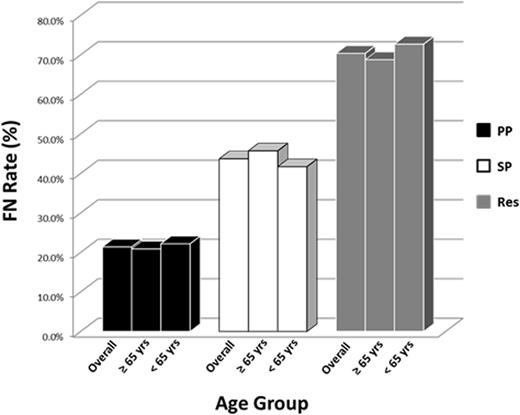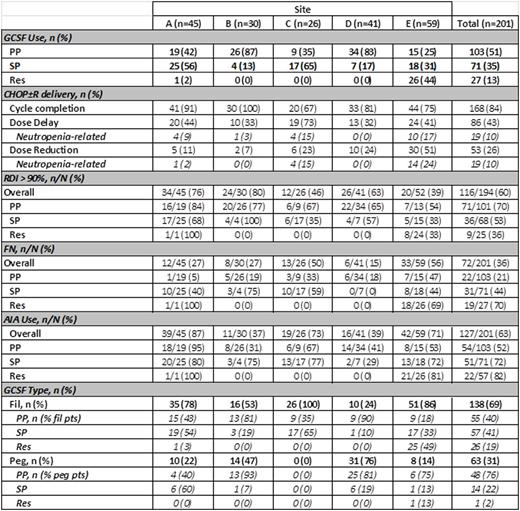Abstract
Background:
First-line aNHL is usually treated with the myelosuppressive CHOP±R regimen. GCSF has been demonstrated to reduce the risk of neutropenia, but published data on GCSF use in Canadian pts with aNHL is lacking. We characterised real-world GCSF use for Canadian pts with aNHL receiving CHOP±R.
Methods:
5 Canadian centres reviewed charts retrospectively for pts with aNHL who received CHOP±R and GCSF between Jan 1, 2010 and June 30, 2014. The proportions of pts receiving primary prophylaxis (PP; GCSF started any day 2-6 of CHOP±R cycle 1), secondary prophylaxis (SP; GCSF started on any day 2-6 of cycles other than cycle 1), or Rescue (Res; GCSF started any day ≥7 in all GCSF supported cycles) were estimated. Dose reductions or delays, relative dose intensity (RDI), febrile neutropenia (FN) rate, anti-infective agent (AIA) use, and type of GCSF were recorded.
201 pts were enrolled. 55% pts were male and median (range) age was 69 (22, 91) yrs with 56% ≥65 yrs. 92% pts had diffuse large B-cell lymphoma and 54% pts had stage IIIA - IVB disease.
PP was used in 103 (51%) pts, SP in 71 (35%) pts, and Res in 27 (13%) pts. More (62%) PP pts were ≥65yrs compared to SP (46%) or Res (56%) pts. 85% PP, 85% SP, and 74% Res pts completed their planned CHOP±R cycles. 43% pts had ≥1 dose delay, more commonly SP (56%) than PP (37%) or Res (30%) pts. Neutropenia-related dose delays occurred for 10% pts, less often with PP (5%) than with SP (13%) or Res (19%). Dose was reduced for 26% pts, more often for Res (56%) than PP (20%) or SP (24%) pts. 10% pts experienced neutropenia-related dose reductions, less often with PP (3%) than SP (11%) or Res (30%). 60% pts achieved RDI >90%, more frequently PP (70%) than SP (53%) or Res (36%) pts.
138 (69%) pts received filgrastim (fil) and 63 (31%) pts received pegfilgrastim (peg) as first GCSF. Fil was used equally as PP (40%) and SP (41%), while peg was used mostly as PP (76%). Peg was administered earlier than fil, with median cycle day-of-initiation on days 2 and 5, respectively. More fil than peg pts were ≥65 yrs (63% v 39%).
36% pts had FN, less commonly PP (21%) than SP (44%) or Res (70%) pts. The FN rate was similar for pts ≥65yrs (35%) and <65yrs (37%); this observation was consistent for PP (21% and 22%), SP (46% and 42%), and Res (69% and 73%) (Figure 1). AIA were used in 63% pts overall and in 52%, 72%, and 82% of PP, SP, and Res pts, respectively.
Differences between sites were common (Table 1).
Conclusions:GCSF was provided most often as PP. Res was used infrequently and predominantly at a single site. CHOP±R delivery was perturbed least frequently for PP pts. Neutropenia-related dose delays and reductions, FN rate, and AIA use were lowest amongst PP pts. FN rates were similar in older and younger pts.
FN rates according to type of GCSF use and age
Outcomes by type of GCSF use and study site
Kouroukis:Amgen: Research Funding; Janssen: Research Funding; Karyopharm: Research Funding. Sehdev:Amgen: Consultancy, Speakers Bureau. Poulin-Costello:Amgen: Employment, Equity Ownership. Gillesby:Amgen: Employment, Equity Ownership. Robson:Amgen: Employment.
Author notes
Asterisk with author names denotes non-ASH members.



This feature is available to Subscribers Only
Sign In or Create an Account Close Modal